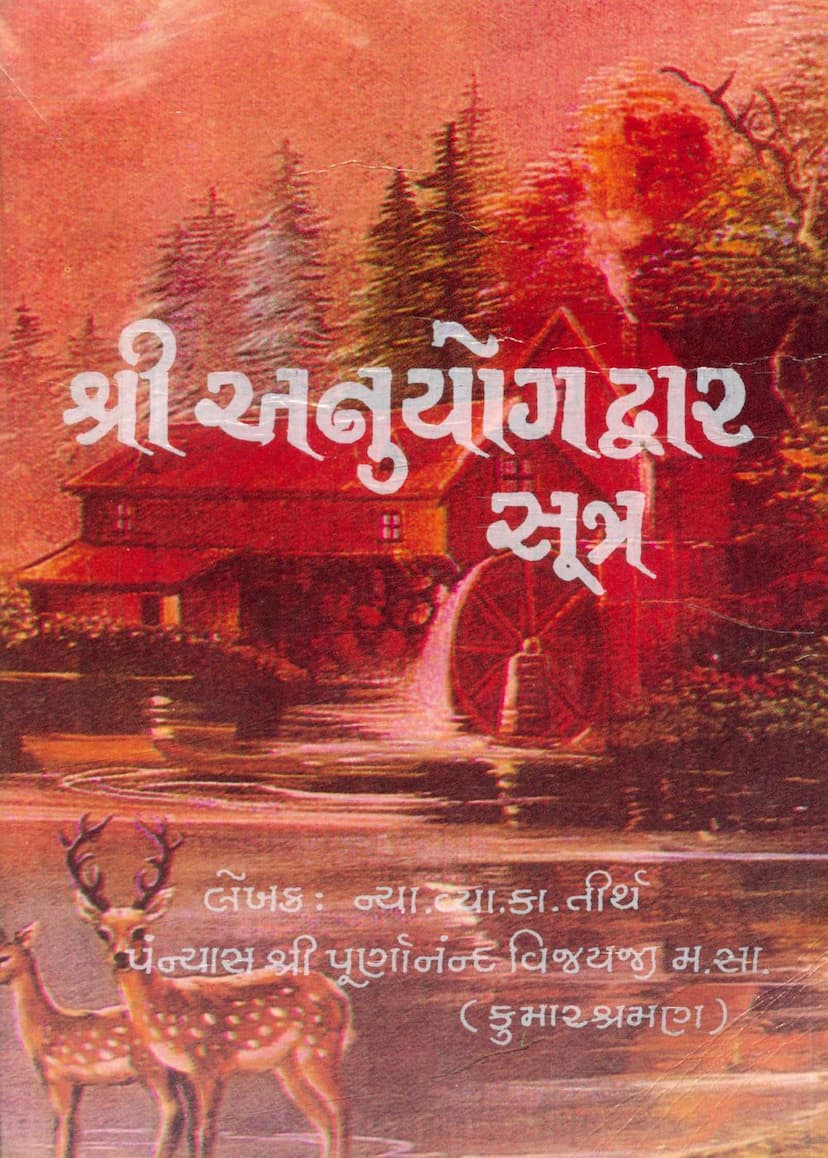Anuyogdwar Sutra
Added to library: September 1, 2025

Summary
Summary of the Anuyogdwar Sutra (authored by Purnanandvijay)
This document is a Jain text titled "Shri Anuyogdwar Sutra," authored by Nyay, Vya, Ka, Tirth, Pannyas Shri Purnanand Vijayji (Kumarsraman). It is published by Jagjivandas Kasturchand Shah. The text is a comprehensive commentary and elaboration on the Anuyogdwar Sutra, considered one of the foundational texts of Jain Agamas.
The book is dedicated to the author's Guru, the late 1008 Shri Vidhyavijayji M.S., recognizing his profound influence and guidance. The publication acknowledges the financial support from various Jain trusts and individuals, including the Bavan Jinalay, Bhayandar (West), and the Shambavnath Jain Derasar Trust, Borivali (West).
Key Themes and Contents:
The Anuyogdwar Sutra, as presented in this work, serves as a gateway to understanding the vast Jain Agamas. Its primary purpose is to elucidate the methodology and principles for interpreting the complex and profound teachings within the Jain scriptures.
The book delves into several critical concepts:
- Anuyog: The text begins by defining "Anuyog" (literally meaning "doorway" or "path") as a system for understanding the sacred texts. It emphasizes that the Anuyogdwar Sutra itself is the key to unlocking the knowledge contained within the 45 remaining Agamas.
- The Four Doors of Anuyog: The work extensively discusses the four essential "doors" or methods of inquiry used in Jain scripture interpretation:
- Upakram (Introduction/Beginning): This section likely deals with the initial setup, context, and purpose of a scriptural text. The book indicates that Upakram is a significant part of the Anuyogdwar Sutra.
- Nikshep (Classification/Placement): This is a crucial interpretive tool in Jainism, involving a seven-fold classification (Nama, Sthapana, Dravya, Kshetra, Kaal, Bhav, and finally the interplay of these) to understand any concept or entity in its entirety. The text provides detailed explanations of these Nikshepas, particularly in relation to the concept of "Avashyak" (obligatory duties).
- Anugam (Consequence/Flow): This discusses the logical connection and flow of ideas within the scriptures, often involving the relationship between different sutras and concepts. It mentions Niryukti (commentaries) as essential for this understanding.
- Naya (Viewpoint/Perspective): This explores the different valid perspectives (Nayavadas) from which reality can be understood, emphasizing the Syadvada principle that truth is multi-faceted. The text discusses seven Nayas.
- Avashyak (Obligatory Duties): A significant portion of the book is dedicated to explaining the six Avashyaks (Samayik, Chaturvinshti-stavan, Vandan, Pratikraman, Kayotsarg, and Pratyakhyan), which are fundamental Jain practices. The author meticulously breaks down the meaning, purpose, and application of each Avashyak, often illustrating with examples and elaborating on their philosophical underpinnings.
- Jnan (Knowledge): The text categorizes and explains the different types of Jain knowledge, including Mati-jnana, Shruta-jnana, Avadhi-jnana, Manahparyaya-jnana, and Kevala-jnana. It highlights the limitations of sense-based knowledge (Mati-jnana) and the supreme nature of Kevala-jnana.
- Substance (Dravya) and its Categories: The work discusses the fundamental Jain concept of Dravya (substance) and its various aspects, including Paramāṇu (atom), Skandha (aggregate), and their permutations. It also touches upon the five Astikayas (Dharma, Adharma, Akasha, Jiva, and Pudgala), explaining their role in the Jain cosmology.
- Time (Kaal): The text explores the Jain concept of time, including Pūrvakāla, Palyopama, and Sagaropama as measures of immense durations.
- Author's Intent and Gratitude: The author expresses his gratitude to his gurus and patrons, acknowledging the challenges faced during the writing process and the blessings received. He hopes the book will serve as a guide for those seeking deeper knowledge of Jain Agamas.
Methodology:
The author follows the traditional approach of Jain scholarship, meticulously explaining the terminology, concepts, and methodologies of scripture interpretation. The book serves as a guide to understanding the intricacies of Anuyoga, thereby facilitating a deeper comprehension of Jain philosophy and practice. The author's extensive knowledge of Sanskrit, Prakrit, and Agamas is evident throughout the commentary.
Overall Significance:
The Anuyogdwar Sutra, as presented by Purnanandvijay, is a vital resource for understanding the epistemological and interpretive framework of Jainism. It provides a systematic approach to navigating the complex scriptural landscape, making the path to genuine knowledge (Samyak-jnana) more accessible to earnest seekers. The detailed analysis of Nikshepa, Nay, and the Avashyaks makes this a valuable text for scholars, practitioners, and students of Jainism.